How to care for Chinese miracle cucumbers to get a great harvest?
Cucumber Chinese miracle does not look like the usual varieties of domestic breeding. Differences are observed both in plants and in the fruits themselves. The bushes are tall vines that can reach a length of 4 m! And their fruits grow up to 60 cm.
Russians have known this variety for a long time - it is grown in all regions of our country. Many summer residents claim that the Chinese cucumber surpasses most of the known varieties and hybrids in taste.
The content of the article
Description of the variety of cucumbers Chinese miracle
Cucumbers Chinese miracle belong to the indeterminate type of plant. The cucumber grows only upward, the foliage is not abundant, which makes it possible to plant seedlings close to each other, without fear of thickening of the plantings.
The type of flowering is female - such plants do not need help with pollination. Inflorescences are formed by a bunch. The root system is branched, well developed.
The plant requires compulsory pinching and garter. Possesses high resistance to diseases dangerous for the pumpkin family, and adapts well to weather variability.
Harvesting is started 2 months after germination. Fruit ripening is amicable, in the open field the culture bears fruit until early autumn, and in the greenhouse fruiting continues until winter.
The variety is recommended for growing in all regions of Russia, including Siberia and the Urals.
reference! The Chinese variety belongs to a special subspecies under the general name Chinese cucumbers.
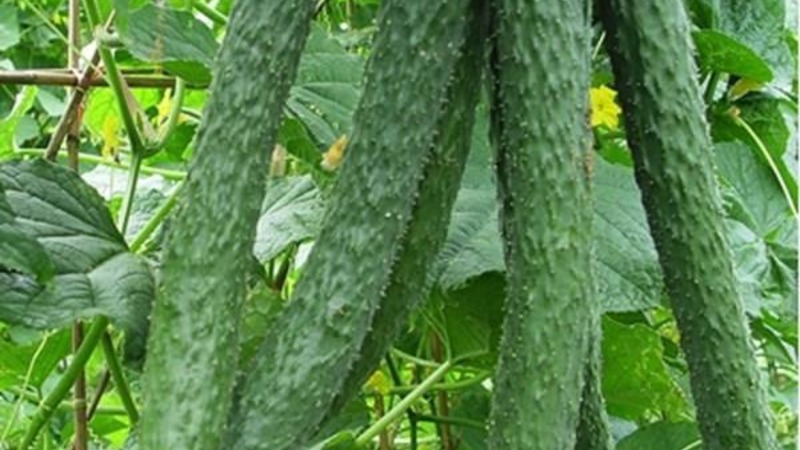
Advantages and disadvantages
Culture has many positive characteristics:
- high yield rate;
- uncomplicated agricultural technology;
- persistent immunity to diseases;
- long-term fruiting;
- adaptation to temperature extremes;
- great fruit taste;
- marketable condition;
- versatility in cooking.
Among the negative sides:
- the need for pinching;
- garter;
- short storage.
Differences from domestic varieties
The oriental variety differs from the domestic variety in late ripening, the fruits are ready for use only 60-70 days after planting. Another feature: if a piece is cut off from a growing vegetable, it will not stop growing or wither, but will continue to develop.
Also, the culture has a more powerful root system, therefore, the bush itself. The fruits are much longer and are able to fully form even in shaded areas. Taste characteristics are superior to short-fruited domestic varieties and some subspecies of Dutch selection.
Fruit characteristics
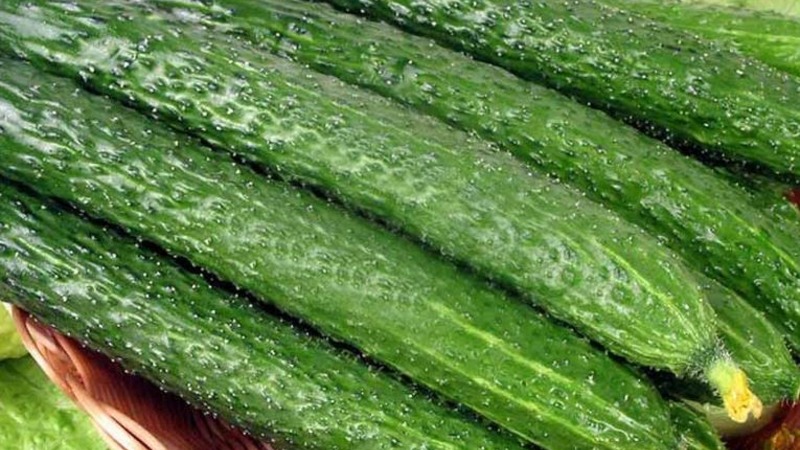
Fruits, which are just beginning to form, look unusual: they are 10-12 cm long, they are prickly and ribbed. With a length of 10 cm, their diameter is no more than 1 cm.
Vegetables grow quickly, and soon their thickness reaches 7 cm, and their length increases to 40-50 cm. By the time of ripening, the cucumbers become smoother and smoother.
Average weight - 500 g, deep green color, sweet taste, no bitterness. The peel is thin, tender, the pulp is juicy, crispy, aromatic.
Ripe vegetables withstand transportation without losing their presentation, but do not forget about a short shelf life. In just a few days, the Chinese miracle begins to fade. Only a high demand for this vegetable allows farmers to sell finished products in a timely manner.
In cooking, cucumbers are involved in the preparation of a variety of fresh dishes: salads, side dishes, sandwiches. Vegetables are suitable for harvesting for the winter (but not in whole-fruited form): preservation, pickles and marinades. Cucumbers can withstand heat treatment and retain their taste for a long time.
The photo shows the Chinese miracle cucumber.
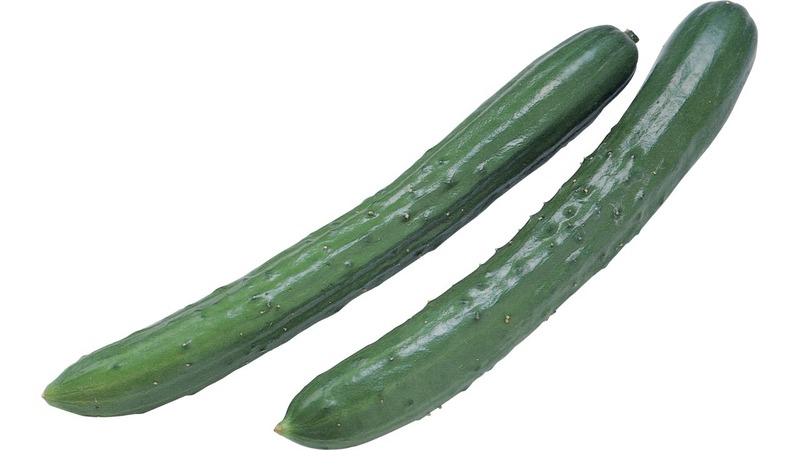
Yield
The yield of one seedling is at least 10 kg of fruits... Therefore, provided that 3 plants are planted per 1 sq. m it is possible to collect up to 30 kg of fruits from 1 sq. m. With prolonged fruiting, this figure rises. It is for this reason that it is convenient for farmers to grow the variety for commercial purposes.
The ability to adapt to any weather conditions makes it possible to obtain rich harvests throughout the territory of the Russian Federation.
reference! The yield of greenhouse seedlings exceeds that of plants planted in open ground.
How to grow a cucumber Chinese miracle
In the south of our country, the seeds of cucumbers The Chinese miracle can be sown directly into open ground. This is a heat-loving plant that will sprout at an air temperature of + 20 ... + 22 ° C. The soil temperature by this time should be more than + 15 ° C, otherwise the seed material will die in the ground.
In other regions, the cultivation of cucumber is recommended by the seedling method.
Sowing seeds and caring for seedlings
The seedling period is 25-30 days, the approximate time for sowing seeds: the beginning or the second half of April. The final dates will determine the climatic characteristics of your region.
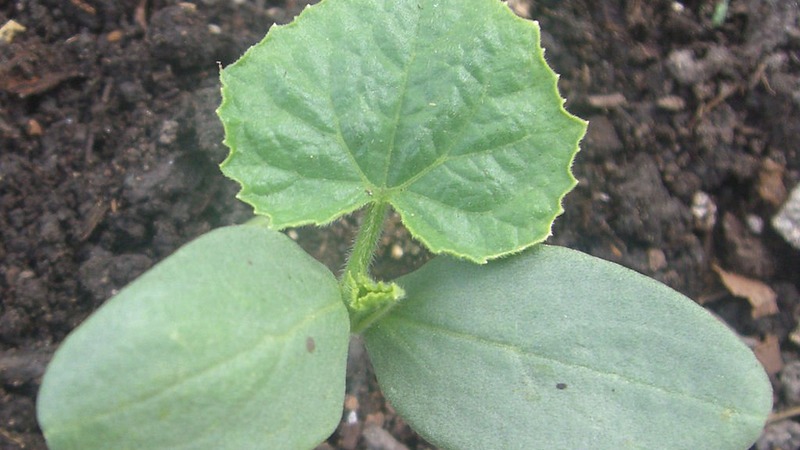 The variety does not differ 100% germination, therefore it is recommended to prepare the seed material well. The further development of plants will depend on competent preparation.
The variety does not differ 100% germination, therefore it is recommended to prepare the seed material well. The further development of plants will depend on competent preparation.
Preparation for planting consists of several stages:
- Calibration... The grains are laid out on the table and carefully inspected for visible defects. Crooked, small, dark grains will not be suitable for sowing.
- Definition of emptiness... Dissolve 3 g of salt in 100 ml of water and place the grains in the solution. Hollow inside, that is, without a germ, will soon float to the surface. They are disposed of immediately.
- Disinfection... In a weak solution of pink manganese, the seeds are left for 20 minutes. Then washed with running water.
- Germination... The grains are placed on a cloth soaked in warm water and left in a dark room at a temperature of +30 ° C. The first shoots will appear in 2 days.
The soil is prepared from peat, sod land, humus and sawdust mixed in equal proportions. The resulting mixture is spilled with a hot solution of dark potassium permanganate to destroy the pathogenic flora.
Only individual containers are suitable for planting, since cucumbers do not take root well after picking and planting.
Seed material is sown to a depth of 1 cm and slightly moistened with warm, settled water. After 5 days, the first shoots appear. The room temperature should not be lower than +22 ° C, and the daylight hours should not be less than 10 hours. In such conditions, the seedlings will quickly grow.
The culture is moisture-loving, so the seedlings watered profusely as the topsoil dries. At the same time, moisture stagnation should not be allowed, this will negatively affect the young roots. In addition, the risk of fungal infections increases. For the outflow of excess moisture, small drainage holes are made at the bottom of the planting containers.
After watering, the soil is superficially loosened, thereby improving the air permeability of the soil.
1 week before transplanting, the seedlings are hardened in outdoor conditions. Seedlings are taken out into the open air in the daytime for several hours at a temperature not lower than +18 ° C.
Transplantation and further care
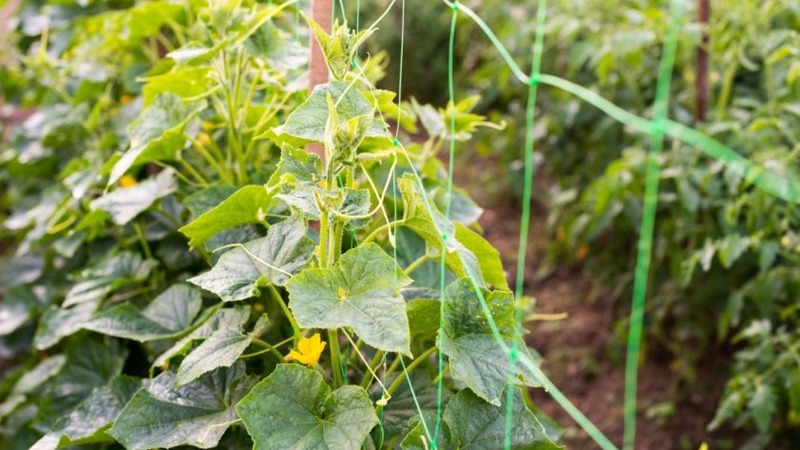
Cucumbers are transplanted into beds well-lit by the sun and protected from the wind. For 1 sq. m place no more than 3 seedlings. After transplanting, they are watered with warm, settled water, covered with a film for several days.
reference! In order for the seedlings to take root and grow faster, they are transplanted together with a clod of earth.
Watering at least 2 times a week, spending on 1 sq. m not less than 10 liters of water. So that the beds do not dry out longer, they are mulched with straw. Additionally, mulch performs a preventive function, protecting the beds from ground pests.
The culture is fed once every 2 weeks, using a full range of minerals or organics. From organic matter, an infusion of weeds in a ratio of 1:10 is suitable. The most used ready-made fertilizers are Zdraven and Agricola.
reference! To relieve plants from stress, during adverse weather conditions (drought, heavy rains) in feeding add stimulants such as Novosil or Energen. They replace vitamins, increasing the immunity of seedlings.
Stepson and garter
A tall plant needs an obligatory garter, since the stem cannot withstand the severity of the forming fruits. For the garter, a trellis or wooden stakes are installed. Fixation on a trellis is more popular with gardeners, as it does not harm the plants.
Stepsonizing consists in removing all the lower stepsons and leaves, but not higher than 40 cm from the ground. When in contact with wet beds, the lower leaves will begin to rot, which can cause the development of fungal spores.
When the main lash reaches the top of the trellis, it is pinched. If the main stem is left to grow further, the height of the seedling will reach 4 m.
Prevention of diseases and pests
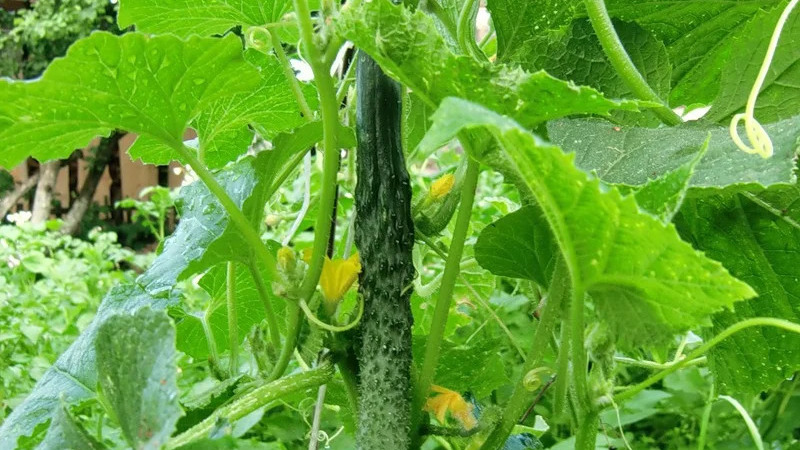
In unfavorable conditions, the plant can be affected by powdery mildew and downy mildew. Downy mildew appears from excessive moisture or boggy soil, while powdery mildew - from drought and thickening of plantings. Both diseases are fungal and are characterized by the appearance of a white powdery coating on the leaves, flowers and stem of the plant.
In the fight against powdery mildew the fungicidal preparation Oxyhom is used. Dissolve 20 g of the preparation in 10 l of water and spray it twice with an interval of 2 weeks.
"Topaz" remedy will relieve downy mildew. 1 ampoule is dissolved in 10 liters of water and sprayed three times with an interval of 10-14 days.
Juicy cucumber foliage massively attracts aphids, which, with a massive defeat, can destroy all plantings. An effective remedy in the fight against a pest is Fitoverm. 5 ml of the agent is dissolved in 1 liter of water and the plants are treated twice with an interval of 2 weeks.
Carrying out preventive measures is guaranteed to relieve the summer cottage of many diseases and pests. Prevention includes: moderate and timely watering, loosening, weeding, mulching the beds and airing protected structures. Compliance with the rules of crop rotation plays an equally important role - you should not grow cucumbers in the same place for several years in a row.
Collection, storage and use of the crop
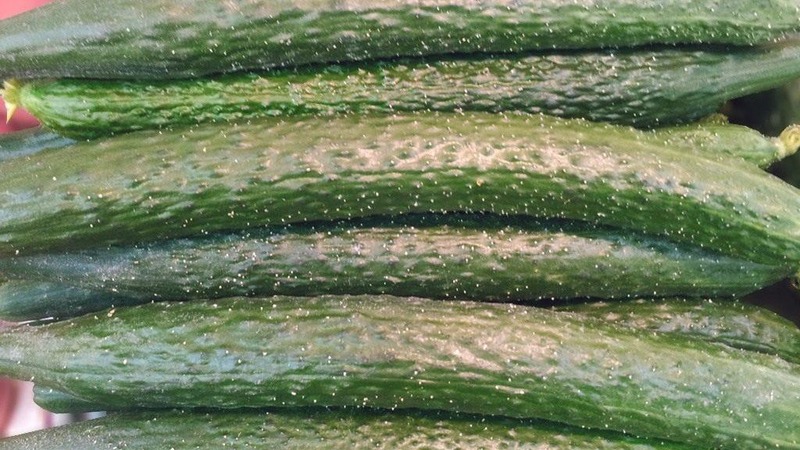
Mass ripening begins 2 months after sowing and lasts until the first frost. If you pick ripe vegetables every 5 days, there is a high probability of the formation of multiple new ovaries. Fruits do not outgrow, crack or coarse.
reference! The sooner the first fruits are harvested, the more abundant further fruiting.
Ripe vegetables cannot be stored. After a few days, they lose both their taste and appearance. Therefore, after collecting them, they are immediately put into use or sold in sales markets.
For preservation, vegetables are cut into pieces, their unusually delicate taste is harmoniously combined with other vegetables. Also, these cucumbers are good when lightly salted.
Variety reviews
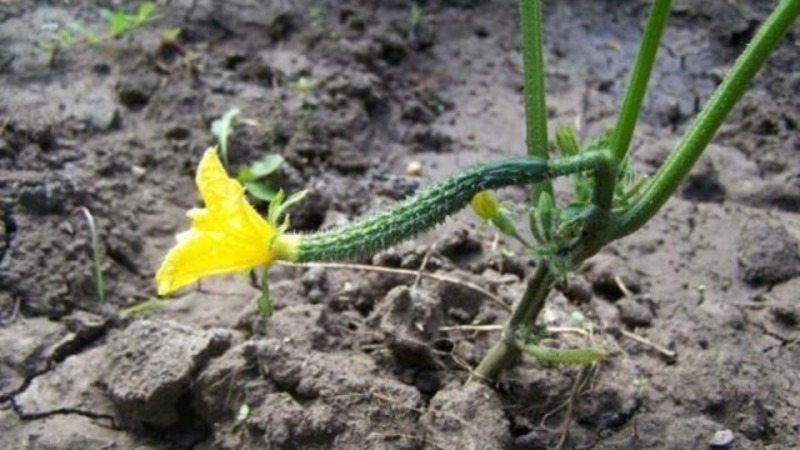
Many summer residents grow Chinese cucumbers on their plots and some of them are happy to share their impressions:
Ekaterina, Syzran: “This is truly a real curiosity! Extraordinarily attractive, the length of my fruits is never less than 45 cm, even, beautiful, bright green. The peel is thin, tender, the pulp is juicy, without the slightest bitterness. It is easy to take care of them, the only need is to install a trellis.But for such a miracle, this is a trifling obstacle. "
Svetlana, Voronezh: “Several years ago I bought the seeds of this cucumber and since then I have only planted it in my garden. In care, he is unpretentious, does not require increased attention. It grows quickly, does not get sick, and bears fruit more than well. The fruits are equally tasty both in fresh dishes and in pickles. In a word, a miracle of miracles! "
Conclusion
The Chinese variety has become widespread in Russia. Due to its many advantages: easy care, high yield, increased resistance to adverse conditions and diseases, cucumbers continue to join the ranks of Russian fans. And delicious and unusual fruits, perfect for any dish, have long won the hearts of housewives.